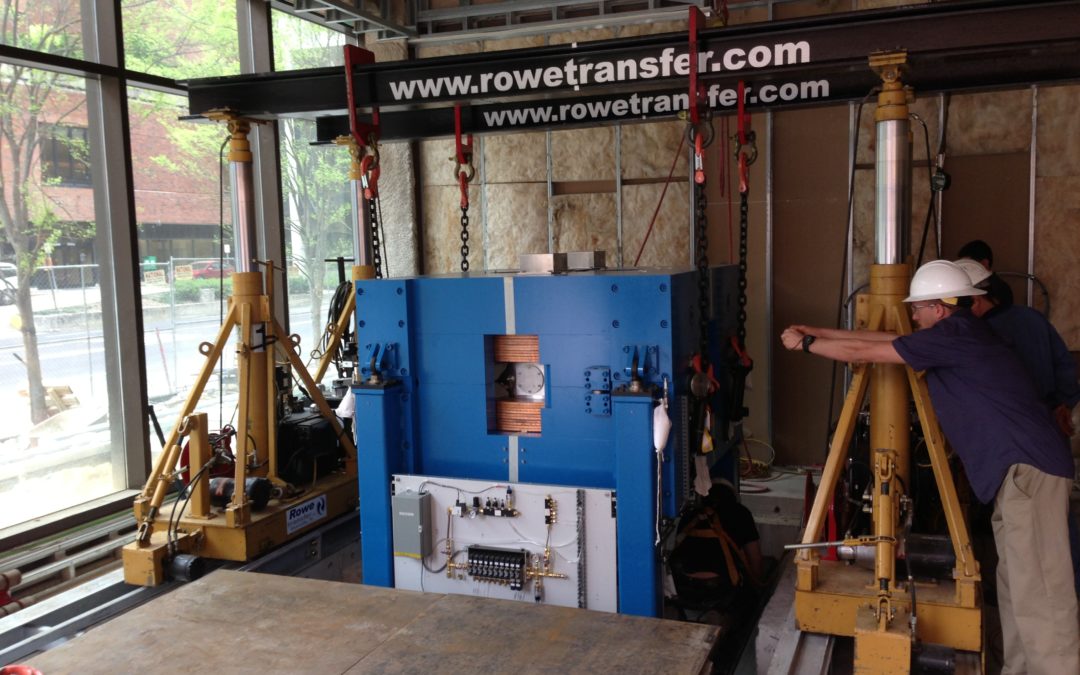You know that Rowe Transfer is an industry leader in transporting heavy equipment across large and small distances. We’ve built a strong reputation over the years of providing the highest quality service, as well as a safe and secure transport for your equipment.
What you probably don’t know is how we go about creating a detailed plan for moving your heavy equipment and executing that plan so you can get your production team back up and running. At Rowe Transfer, our staff plans and implements our projects to ensure your heavy equipment arrives safely.
To put it simply, rigging engineering is planning for the safe and efficient execution of lifting, moving, and transporting very large and cumbersome objects. It involves developing a plan that mitigates risk and may require creating materials like drawings, procedures, calculations, and risk assessments.
Rigging engineers take on a high-stress role in a moving project. Moving heavy equipment can oftentimes be very expensive, and the equipment is indispensable to a company’s production capabilities. One mistake in the moving process could create very costly damage and delays. That’s why rigging engineers are highly skilled and highly trained to handle such an important part of the moving heavy equipment process.
To better understand the roles engineers play in our transportation projects, here’s a quick glimpse at everything we’re doing behind the scenes for your heavy equipment.
Establish rules and standards for a rigging project
Different industries have different standards and specifications that must be met when transporting heavy equipment. Adding another layer, depending on the industry those specs and standards may differ across regions, states, and countries. It can be a challenge to get alignment with the rigging standards, safety rules to follow, industry standards, and which ASME codes and rules apply.
Before any project can begin, these details must be established and communicated with staff who are executing the move. This ensures we’ve addressed unforeseen issues that can put a stop to your transportation project before it even starts.
Establish client specifications
Clients often have their policies for rigging and lifting heavy equipment for their staff or within their facilities. Sometimes it will differ even with the specific sites where they are. It’s critically important to establish and understand these specifications early on to define those requirements. With everyone on the same page, all parties involved will have the chance to follow and agree on the proper steps moving forward and sign off on what needs to happen next.
Logistics
This is one of the most important steps for rigging engineers. When transporting large, heavy equipment, it’s imperative to find routes that create the least amount of impact on the surrounding community while keeping your equipment safe and getting it to its established destination on time. This includes route studies, examining road and bridge conditions, finding construction areas, and finding permits.
The importance of this part of the process cannot be overstated. Our engineers work with our rigging team to identify obstructions or any other challenges that might impede or inhibit a smooth transfer of your heavy machinery.
Securing rigging equipment to your heavy machinery
Moving your heavy machinery safely and securely means attaching it properly to our rigging equipment. This may seem straightforward, but every piece of equipment can vary in size, shape, and weight, and securing machinery properly can be the difference between a smooth transfer or repairing damage upon arrival to its new home. We take into account all factors in lifting your equipment, including weight distribution and unique sizes, to prevent an awkward lift.
By securing your equipment safely, you can trust that moving your heavy machinery won’t mean compromising performance or incurring an added expense.
Execute established plan
The plan is ready, the route and equipment are ready, so all that’s left is to make this plan happen efficiently, effectively, and safely. Whether it’s a simple move for your heavy machinery or it has grown into a complicated project, the rigging engineer is involved in executing the established plan.
Executing the plan can be as simple as writing and reviewing a two-page document or can grow into something much more complicated. In either case, the most important thing is that the plan is communicated and understood on all levels of the operation.
A Transportation Company Ready to Move Your Heavy Equipment
While much of the work performed by your rigging engineer is done behind the scenes, you can trust that the team at Rowe Transfer is here to provide all the support, planning, and insight your project needs to be completed safely.
If you’re ready to move valuable heavy machinery, don’t take the risk to your company’s safety and waste time trying to tackle this type of project on your own. At Rowe Transfer, we understand just how important your equipment is to your company’s success, and that’s why we’ll bring our years of expertise and experience to move your heavy machinery. We’ll provide a detailed plan so you know exactly what to expect, and then get the job done efficiently so you can get back to running and growing your business. Rowe Transfer has over a century of experience helping individuals and companies transport some of the largest machines on earth. We have the expert and knowledgeable staff, the heavy-duty equipment, and the trucks, logistics, and planning capabilities you need to move your valuable machinery and ensure that it arrives at its new destination safely and on time. Contact us today for a free quote or to learn more about our transportation, rigging, crating, and warehousing capabilities. You can reach us by phone at (865) 523-0421 or online at our contact page.

